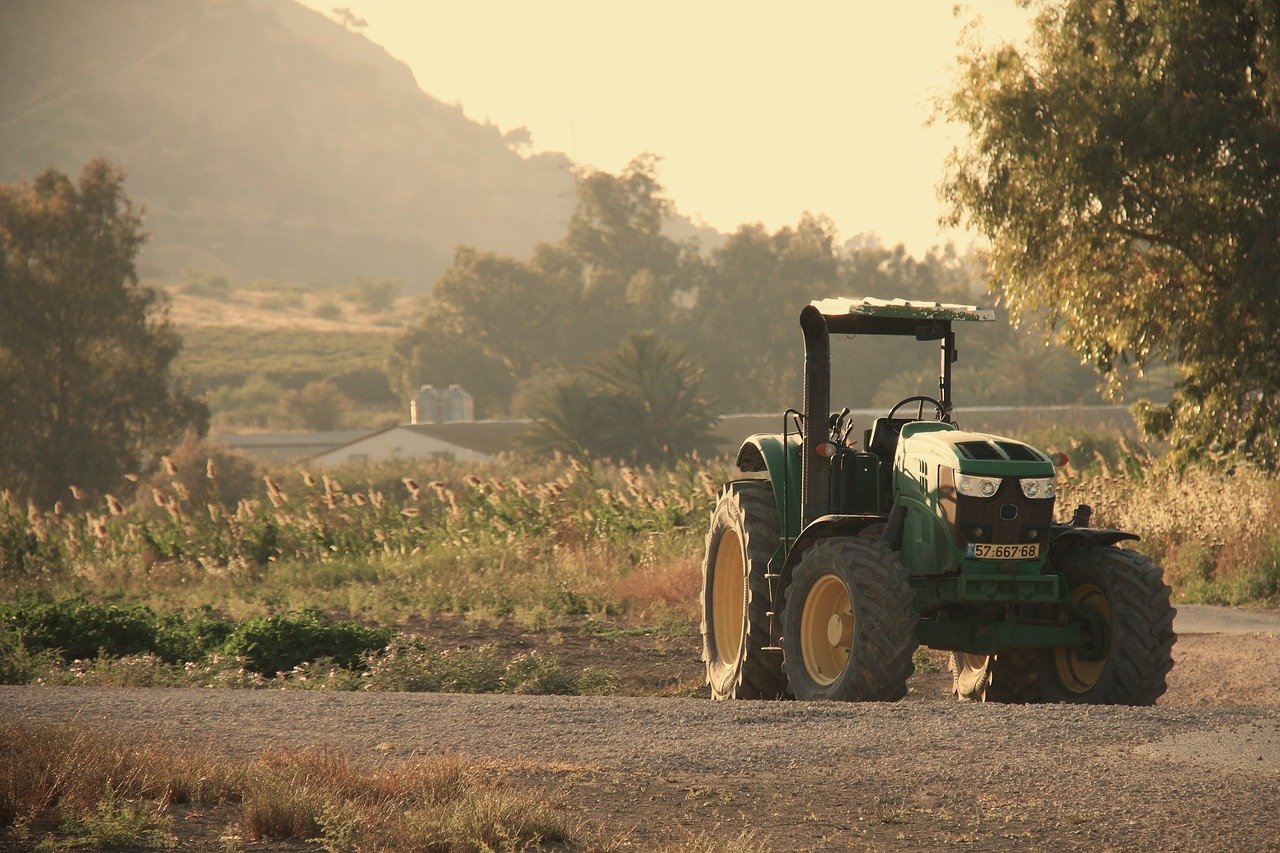
You can make soil better by using agriculture activated carbon. This material helps soil keep nutrients for more time. It keeps the soil strong and helps good microbes grow. Activated carbon also takes away bad things like heavy metals and dioxins. Studies show it lowers how much copper and zinc plants take in. This makes your crops safer and healthier. Carbón activado para suelos protects your crops and helps farming last longer. You get more crops and healthier plants with these changes.
Principales conclusiones
Agriculture activated carbon helps soil by holding nutrients and helping good microbes. Using activated carbon can lower bad things like heavy metals and pesticides in soil. This makes crops safer to eat. Mix activated carbon with organic matter to make soil better. It helps soil hold water and gives plants more nutrients. There are different kinds of activated carbon for different jobs. Pick the right kind for your soil and crops. Using activated carbon often can help soil for a long time. It can make soil have more organic matter and keep more water. Try activated carbon on a small spot first to see what happens. Do this before using it everywhere on your farm. Turning farm waste into activated carbon and biochar cuts down on pollution. It also helps farms stay healthy for a long time. Good soil with activated carbon grows stronger plants and bigger harvests. It also makes farms stronger against problems.
Agriculture Activated Carbon Overview
Definición
Utiliza agriculture activated carbon to help soil and crops. This special activated carbon comes from farm waste or leftovers. People use it in many farming jobs. Farmers add it as a pesticide. They also mix it into animal feed and use it to clean things. Winemakers use it to clean grape juice and take out colors they do not want. It helps plants like Eucalyptus saplings grow better. Agriculture activated carbon is different from regular activated carbon. It works to keep soil healthy and crops safe.
Consejo: If you add activated carbon to your soil, plants can grow faster. Many gardeners see stronger roots and greener leaves.
Tipos
There are many types of activated carbon you can pick. Each type is good for different jobs. The table below shows the main types, what they are like, and how people use them:
Tipo de carbón activado | Propiedades | Aplicaciones |
|---|---|---|
H-type | Positive charge, hydrophobic | Water treatment, heavy metal removal |
L-type | Negative charge, hydrophilic | Neutralizing bases, water treatment |
Carbón activado en polvo | Fine particles, high surface area | Liquid and gas treatment |
Carbón activado granulado | Small granules, easy recovery | Bed reactors, soil filters |
Extruded Activated Carbon | Cylindrical shapes, low dust | Continuous flow systems |
Activated Carbon Felt | Felt-like structure | Custom filtration |
Carbón activo impregnado | Enhanced adsorption | Targeted pollutant removal |
Carbón activado catalítico | Promotes chemical reactions | Speeds up reactions |
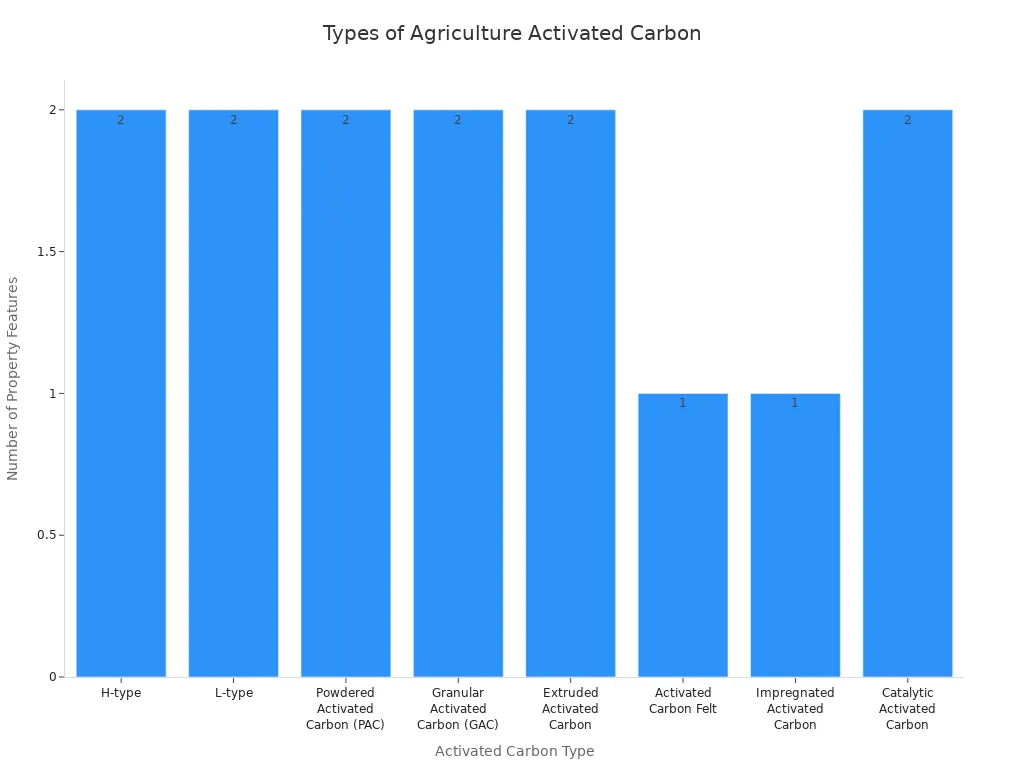
You may hear about biochar too. Biochar is like activated carbon but comes from burning plant material. People use biochar to make soil better, hold nutrients, and help good microbes. Farmers make biochar from farm waste. This is smart for farming that lasts a long time.
Nota: Powdered activated carbon mixes well into soil. Granular activated carbon is easy to take out and use again.
Production
Puedes make activated carbon from many farm leftovers. Farmers use shells, seeds, and plant waste. There are two main ways to make activated carbon:
Chemical Activation: You soak strawberry seeds in acetic acid. Then you heat them to 600 °C for two hours. This makes activated carbon that can grab things well.
Physical Activation: You heat pistachio shells at 400 °C. Then you heat them again at 800 °C with carbon dioxide gas. This makes activated carbon with tiny holes.
Biochar is made in a similar way. You burn farm waste at high heat with little oxygen. This makes biochar. You add biochar to soil to help it hold together and keep nutrients.
Consejo: You can use farm waste to make biochar or activated carbon. This saves money and helps the planet.
Both agriculture activated carbon and biochar help soil stay healthy. You can pick the best type and way to make it for your farm or garden.
Activated Carbon Properties
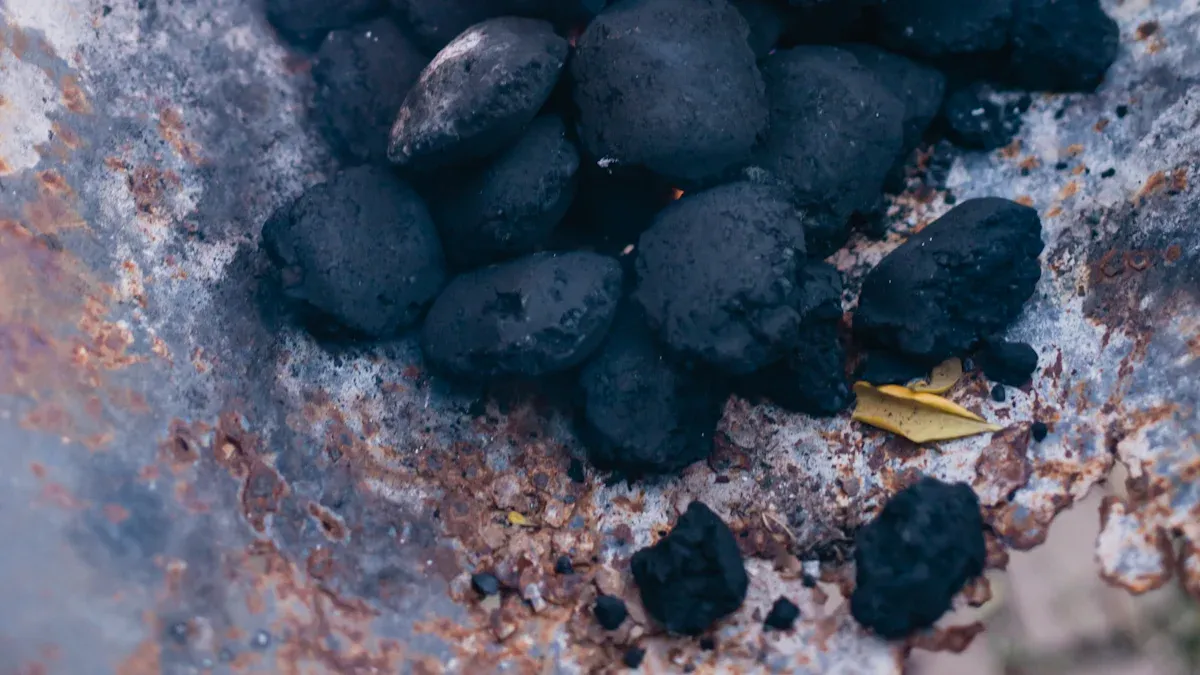
Porosidad
Activated carbon is like a sponge with lots of tiny holes. These pores help soil in many ways. When you add activated carbon, water and air move better in the soil. Plants get more moisture and oxygen. Roots grow deeper and stronger. The soil stays loose and airy. The pores help hold water when it is dry. This keeps plants from drying out fast.
Consejo: If your soil is hard or dry, activated carbon helps it hold water and stay soft.
Here is a table that shows important physical and chemical properties that make activated carbon useful for soil:
Propiedad | Descripción |
|---|---|
High pH | Helps mitigate soil acidification. |
Nutritional content | Provides essential nutrients to the soil. |
Pollutant adsorption ability | Enhances the soil’s ability to retain and filter pollutants. |
Rich pore structure | Improves water retention and aeration in the soil. |
Large specific surface area | Increases the interaction with soil components, enhancing nutrient availability. |
Stable physicochemical properties | Ensures long-term effectiveness in soil health improvement. |
Richness of surface functional groups | Supports various biochemical processes in the soil, promoting microbial activity and diversity. |
Adsorción
Activated carbon works like a magnet for nutrients and pollutants. It traps plant nutrients like nitrogen, phosphorus, and potassium. This keeps nutrients in the soil longer. Plants use them when needed. Activated carbon also grabs harmful things like heavy metals and pesticides. This protects crops and keeps soil clean.
You help the soil nitrogen cycle by aiding nitrogen transformation.
You boost the soil’s ability to hold nutrients with cationic adsorption.
You help the soil store more carbon and reduce nutrient loss.
The table below shows how activated carbon helps soil health:
Benefit/Property | Descripción |
|---|---|
Nutrient Absorption | Absorbs nutrients, reducing loss and improving fertilizer use. |
Pollutant Removal | Absorbs harmful substances, protecting crops and the environment. |
Soil Structure Improvement | Enhances soil’s physical properties, increasing ventilation and water retention. |
Crop Growth Promotion | Improves seedling height, root length, and crop yield. |
Microbial Growth Support | Creates a good environment for helpful microbes. |
Chemical Features
Activated carbon has special chemical features that help soil. It has high pH, which balances acidic soils. It gives nutrients to plants. The surface has many functional groups. These groups help with soil reactions and support good microbes.
You can see some chemical effects in the table below:
Característica | AAC Effect (%) |
|---|---|
Decrease in soil pH | 3.52 – 4.71 |
Decrease in EC | 45.2 – 71.4 |
Increase in available P | 117.5 – 25.9 |
Increase in extractable Zn | 42.0 – 52.2 |
Increase in B | 111.4 – 46.2 |
Increase in Fe | 59.5 – 34.4 |
Using activated carbon helps soil hold nutrients and remove toxins. It supports healthy plant growth. It also makes a better home for helpful microbes. This makes soil healthier.
Beneficios del carbón activado
Nutrient Retention
You want your plants to use all the fertilizer. Activated carbon helps by holding nutrients in the soil. It acts like a sponge when you add it. It grabs nitrate nitrogen, ammonium nitrogen, and phosphorus. This means less nutrient loss from water washing it away. Plants can use these nutrients when they need them.
You also make fertilizer work better. Activated carbon keeps nutrients near the roots. This lets you use less fertilizer and save money. It also stops extra nutrients from polluting water.
Here is a table that shows how activated carbon helps soil keep nutrients and stay healthy:
Descripción de las pruebas | Hallazgos | Implications |
|---|---|---|
Nutrient loss rate comparison | Activated carbon helps soil keep more nutrients, so less nitrate nitrogen, ammonium nitrogen, and phosphorus are lost. | Plants get more nutrients. |
Soil structure improvement | Activated carbon makes soil less dense and improves its structure. | Soil is healthier and plants grow better. |
Cation exchange capacity | Activated carbon’s negative charges help soil swap nutrients better. | Soil gives plants a steady supply of nutrients. |
Activated carbon does not just hold nutrients. It also makes soil better for plants. Using biochar or agriculture activated carbon helps soil keep what plants need most.
Consejo: Mix activated carbon with your fertilizer. You might see greener leaves and faster growth.
Soil Structure
Good soil needs the right structure. Activated carbon and biochar help build this. When you add them, you put more organic matter in the soil. This makes soil lighter and roots can grow easier. Water moves better and plants get more air.
Activated carbon helps soil particles stick together. This makes strong soil clumps. These clumps stop soil from getting too hard. Roots can go deeper and find more water and food.
Here is a table that shows how activated carbon helps soil structure:
Pruebas | Descripción |
|---|---|
Soil organic matter enhancement | Adding activated carbon puts more organic matter in soil, which helps soil structure. |
Microbial activity promotion | Activated carbon helps good microbes grow, making soil clumps stronger. |
Improved soil aggregation | Better soil clumps mean more space for air and water, which helps keep nutrients in the soil. |
Activated carbon and biochar can also trap bad things in the soil. This makes soil safer for crops. This is important if your soil has pollution.
Nota: If your soil is hard or water sits on top, try adding activated carbon or biochar. You will get softer soil and better drainage.
Microbial Activity
Soil microbes are important for plant health. Activated carbon gives them a better place to live. When you add biochar or activated carbon, you feed good bacteria and fungi. These microbes break down old plants and give nutrients to your crops.
You also get more kinds of microbes in your soil. More types of microbes make soil healthier and plants stronger. Activated carbon helps keep soil wet and full of air, which microbes like.
Adding organic materials like activated carbon helps more microbes grow.
Active organic carbon gives energy to soil microbes and helps them grow.
Organic fertilizers change how much organic carbon is in the soil, which helps keep soil and microbes healthy.
You can use activated carbon to make soil better and help plants grow. It also helps clean up polluted soil by helping microbes break down bad stuff. This makes your soil and crops safer.
Consejo: Healthy soil smells nice and earthy. If your soil smells bad, add biochar or activated carbon to help it.
Pollutant Removal
You want your soil to be safe for people and plants. Activated carbon helps take out harmful things from soil. It can remove heavy metals, pesticides, and other bad chemicals. When you add activated carbon, your soil gets a strong way to clean itself.
Activated carbon has a lot of tiny holes and a big surface area. These help it trap and hold dangerous stuff. Think of activated carbon like a sponge that soaks up things you do not want in soil.
Activated carbon can grab heavy metals from water, so it can also help clean soil.
Its many pores and large surface area make it great at holding pollutants.
Biologically changed activated carbon can remove both heavy metals and organic pollutants, so it works for many kinds of pollution.
Sometimes soil has leftover pesticides or metals like copper and lead. These can hurt plants and get into food. Activated carbon helps lower these dangers. It locks up the bad things so plants cannot take them in.
Consejo: If you grow food where there was old pollution, adding activated carbon can make your crops safer to eat.
You can use activated carbon in gardens, fields, or pots. It helps keep plants and people safe. Cleaner soil means healthier plants and better harvests for you.
Casos prácticos
Field Trials
Many field tests show how activated carbon helps crops. Scientists tried it on corn, wheat, and tomatoes. They put activated carbon in the soil. Then they checked how plants grew and how good the soil was. Corn got taller and had stronger roots. Tomato plants made more fruit. The soil held water better and kept more nutrients.
Here is a summary of some field trial results:
Crop | Result with Activated Carbon | Benefit for You |
|---|---|---|
Corn | Taller plants, strong roots | Higher yield |
Tomato | More fruit, greener leaves | Better harvest |
Wheat | Improved soil structure | Healthier soil |
Nota: Field tests show you can grow more crops and get healthier plants by using activated carbon.
Farmer Experiences
Lots of farmers talk about using activated carbon. One farmer had soil that was not good. After using activated carbon, the soil got softer and held water better. Crops looked greener and grew faster. Another farmer saw fewer bugs and stronger roots. Some farmers use activated carbon to fix soil with too many chemicals. They say their vegetables taste better and last longer.
You can learn from these stories:
Try activated carbon on a small area first.
Look for changes in plant color and root growth.
Ask other farmers what happened when they used it.
Farmers often say, “My soil feels alive again!” after using activated carbon.
Research Highlights
Scientists keep studying how activated carbon helps soil. New studies show it traps heavy metals and pesticides. This keeps crops safer. Research also shows activated carbon helps more good microbes grow in soil. These microbes break down old plants and give nutrients to crops.
Some important research findings are:
Activated carbon makes soil structure and water holding better.
It lowers harmful chemicals in crops.
It helps keep soil microbes healthy.
Science shows activated carbon is good for soil health.
Application Methods
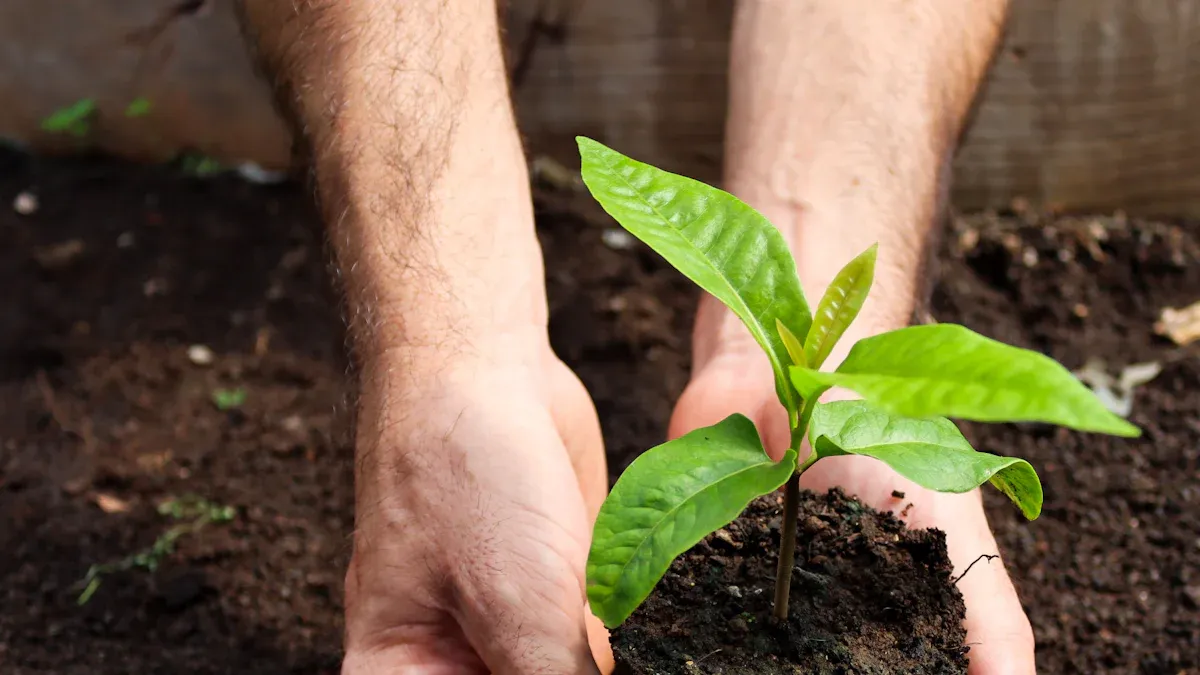
Mixing
You can mix carbón activado directly into your soil. This method works well if you want to improve soil health before planting. Start by spreading activated carbon evenly over the soil surface. Use a shovel or garden fork to blend it into the top 6 to 8 inches. You help the activated carbon reach plant roots this way. Mixing also lets you combine activated carbon with compost or other organic matter. This boosts the benefits for your plants.
Consejo: Always mix activated carbon with organic matter like compost or aged manure. This helps the soil hold more water and nutrients.
You can use this method in garden beds, raised beds, or even large pots. Mixing works best when you prepare new planting areas or refresh old ones. You give your plants a strong start by improving the soil’s structure and nutrient-holding power.
Top-Dressing
Top-dressing means you spread activated carbon on top of the soil. You do not dig it in. This method is easy and quick. You can use it for lawns, established gardens, or around trees and shrubs. Spread a thin layer of activated carbon over the soil. Water the area well so the carbon settles in.
Top-dressing works well when you want to boost soil health without disturbing roots. You can also add organic matter on top at the same time. Rain and watering will help move the activated carbon and organic matter deeper into the soil over time.
Use top-dressing for established plants.
Combine with mulch or compost for better results.
Repeat every few months for ongoing soil improvement.
Rates
You need to use the right amount of activated carbon for the best results. Too little may not help. Too much can waste money. The right rate depends on your soil type and what you grow.
Here is a simple guide:
Soil Type | Activated Carbon Rate | Organic Matter Addition |
|---|---|---|
Sandy Soil | 1-2 pounds per 10 sq ft | Add extra compost |
Clay Soil | 0.5-1 pound per 10 sq ft | Mix with organic matter |
Loamy Soil | 0.5-1 pound per 10 sq ft | Blend with compost |
You should always add carbón activado with organic matter. This helps the soil stay healthy and supports good microbes. If you use compost, manure, or leaf mold, you increase the amount of organic matter in your soil. This makes the activated carbon work even better.
Remember: Test a small area first. Watch how your plants respond before treating a large space.
You can adjust the rates based on your results. Healthy soil has plenty of organic matter and good structure. Activated carbon helps you reach that goal.
Soil Types
You need to know your soil type before you add agriculture activated carbon. Each soil acts differently. Sandy, clay, and loamy soils all have their own needs. When you match your method to your soil, you get the best results.
Sandy Soil
Sandy soil drains water fast. It often loses nutrients quickly. You can fix this by adding activated carbon with plenty of organic matter. The carbon holds water and nutrients. Organic matter helps the soil stay moist and feeds your plants. You should mix both into the top layer. This keeps your plants from drying out and helps roots grow strong.
Clay Soil
Clay soil feels heavy and sticky. It holds water but can get hard and packed. Activated carbon helps break up the soil. It makes more space for air and water. When you add organic matter, the soil becomes softer and easier to work. You should mix activated carbon and organic matter deep into the clay. This helps roots spread and lets water move better.
Loamy Soil
Loamy soil is a mix of sand, silt, and clay. It is the best for most plants. You still get benefits from activated carbon. It helps keep nutrients in the soil and supports healthy microbes. Add organic matter to keep the soil rich. You can use less activated carbon in loamy soil, but always add some organic matter for balance.
Here is a table that shows how activated carbon changes nutrient levels in different soils:
Soil Type | Treatment | Effect on Soil Nutrients (P, K, Zn, B, Fe) | Maximum Increase (%) |
|---|---|---|---|
Arcilla | 2% AAC | Significantly improved available P, K, Zn, B, Fe | 117.5 (P), 60.6 (K), 42.0 (Zn), 111.4 (B), 59.5 (Fe) |
Sandy Clay Loam | 2% BC | Significantly improved available P, K, Zn, B, Fe | 25.9 (P), 60.6 (K), 52.2 (Zn), 46.2 (B), 34.4 (Fe) |
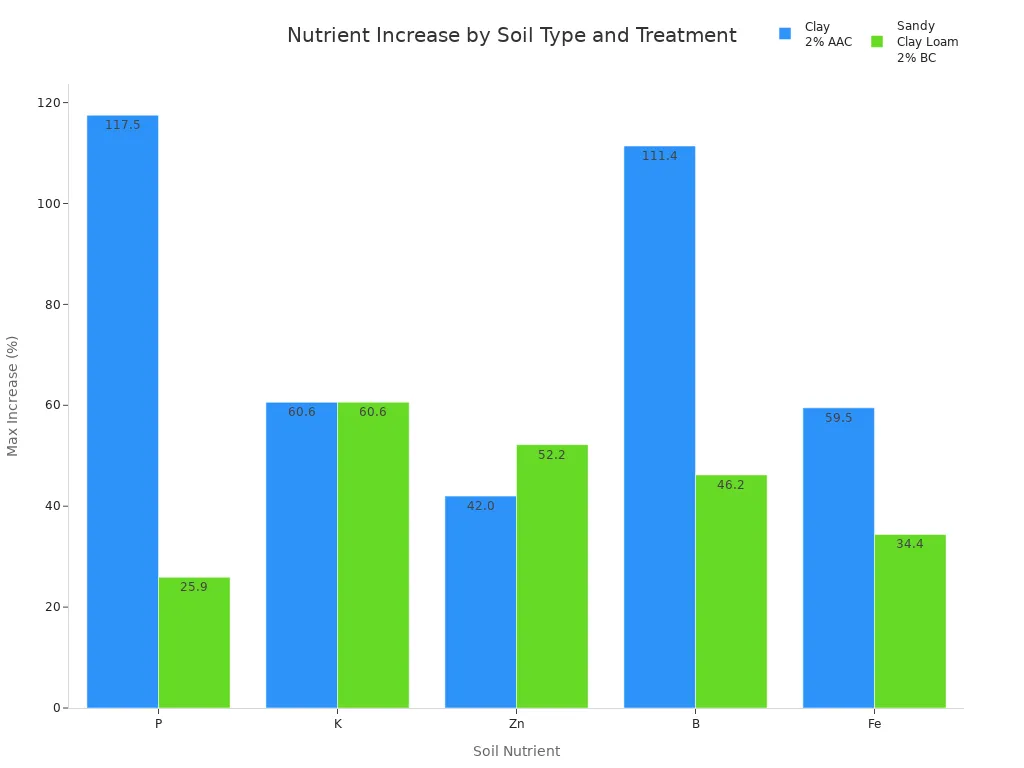
You see that clay soil gets the biggest boost in nutrients when you use activated carbon. Sandy clay loam also improves, but not as much. No matter your soil, always add organic matter with activated carbon. This keeps the soil healthy and helps the carbon work better.
Tip: Test your soil first. If you are not sure what type you have, squeeze a handful. Sandy soil falls apart. Clay sticks together. Loamy soil feels crumbly and soft.
You can improve any soil with the right mix of activated carbon and organic matter. Your plants will grow stronger, and your soil will stay healthy for years.
Desafíos
Coste
You may notice that using agriculture activated carbon can cost a lot. Many farmers face high expenses when they try to improve their soil. You need to pay for soil sampling and lab analysis. These steps help you know how much carbon your soil can hold, but they are not cheap. Upfront costs for buying activated carbon and changing your farming methods can also be high. Sometimes, the money you get back from carbon credits does not cover what you spend. This makes it hard for you to start using activated carbon on a large scale.
Here is a table that shows some common cost challenges:
Challenge | Descripción |
|---|---|
High Costs | You pay a lot for soil tests and lab work. |
Limited Returns | Carbon credits often do not give enough money back to cover your expenses. |
Upfront Costs | You need to spend money before you see any benefits. |
Consejo: Start with a small area to test activated carbon before using it on your whole farm. This helps you manage costs and see results first.
Compatibility
You need to check if activated carbon works well with your soil and crops. Not every farm or garden will get the same results. Some soils, like sandy or clay, may need different amounts of activated carbon. You also need to think about what crops you grow. Certain plants may respond better than others. If you use other soil amendments or fertilizers, you should make sure they do not react badly with activated carbon.
You may find it hard to measure how much carbon your soil stores.
You might not have clear guidance on how to use activated carbon for your land.
You may need to adjust your farming practices to get the best results.
If you are unsure, talk to local experts or extension agents. They can help you decide if activated carbon fits your soil and crops.
Long-Term Effects
You want to know what happens if you use activated carbon for many years. Studies show that repeated use can help your soil in several ways. You get more soil organic matter, which makes your soil healthier. Your soil stores more carbon, which helps fight climate change. You also see better moisture in your soil, which helps your crops grow.
Here is a table that shows some long-term effects:
Effect | Descripción |
|---|---|
You see a big increase, which helps your soil stay healthy. | |
Soil Organic Carbon (SOC) | Your soil stores more carbon for a long time. |
Soil Moisture Content | Your soil holds more water, which helps your crops during dry times. |
Control Andosol (CoA) | Soils without biochar do not show these benefits. |
Recommendation | Using biochar or activated carbon is good for soils with lots of Andosols. |
Over time, you help your soil stay rich and productive. You also support the environment by storing more carbon in your fields.
You may face some challenges, but with careful planning, you can make activated carbon work for your soil and crops.
Sostenibilidad
Waste Recycling
You can help the earth by using farm waste in smart ways. Farms make lots of waste like rice husks and stalks. In Taiwan, farms made 2.14 million tonnes of waste in one year. Burning or burying this waste hurts the land and air. There is a better way to use it. If you use pyrolysis, you change waste into biochar and activated carbon. These products go back into the soil and help crops grow. Recycling waste helps the economy and saves resources.
Evidence Type | Descripción |
|---|---|
Agricultural Waste Statistics | Taiwan farms made 2.14 million tonnes of waste, showing there is a lot to recycle. |
Environmental Concerns | Burning or burying waste damages land and air, so we need better choices. |
Bio-based Circular Economy | Turning waste into useful products cuts down on trash and helps the planet. |
Pyrolysis Process | Pyrolysis changes plant waste into carbon materials, which can become activated carbon and help recycling. |
Recycling farm waste into biochar and activated carbon keeps soil healthy. It also lowers pollution and saves important resources.
Impacto medioambiental
You help the environment when you add biochar and organic matter to soil. These materials help soil keep more carbon. This slows down climate change by trapping carbon in the ground. Biochar and organic matter also make soil better. They help soil hold water and nutrients. You use less fertilizer and water, which keeps rivers and lakes clean. Recycling farm waste means less burning and burying. This gives us cleaner air and land.
Tip: Soil with more organic matter and biochar grows more plants and animals. You help nature when you care for your soil.
Tendencias futuras
More farms will use biochar and organic matter soon. People want new ways to recycle farm waste. Scientists are finding better ways to make biochar and activated carbon from leftovers. You may use smart tools to check how much carbon is in your soil. More farmers will join programs that reward healthy soil. New products will mix biochar, organic matter, and nutrients for better crops.
You can help farming become greener.
You can teach others about recycling and soil health.
You can help build a future with less waste and more crops.
You are important in making the world sustainable. Using biochar, organic matter, and recycled farm waste protects the earth and helps feed people.
When you use agriculture carbón activado and biochar, you notice real changes. These materials make soil healthier and help crops grow better. They also protect the environment. Scientists found that more soil organic carbon makes soil richer and stronger. It helps soil stay healthy during dry times and bad weather. Look at the table below to see the main benefits:
Beneficio | Descripción |
|---|---|
Improved Soil Fertility | Soil organic carbon gives plants important nutrients. |
Resilience to Environmental Stress | More carbon helps soil handle drought and stress. |
Nutrient Cycling | Carbon helps move nutrients around in the soil. |
Soil Structure | More carbon makes soil easier to dig and plant in. |
Carbon Sequestration | Carbon-rich soil helps slow down climate change. |
Try using biochar or agriculture activated carbon on a small area first.
You can ask local experts if you need help or advice.
By caring for your soil, you help your farm and your whole community.
